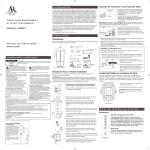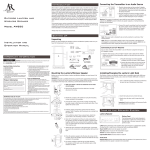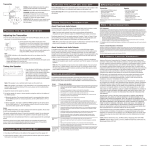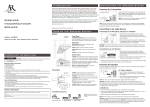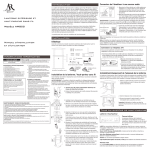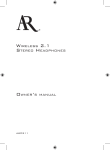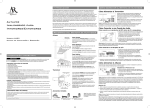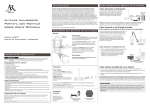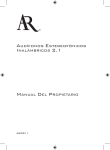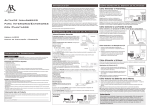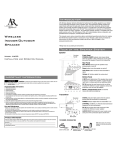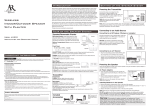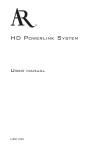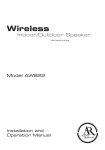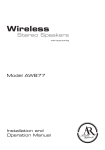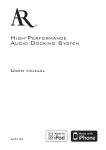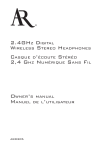Download Acoustic Research AW851 User's Manual
Transcript
Introduction Outdoor Lantern and Wireless Speaker Connecting the Transmitter to an Audio Source AR’s Outdoor Lantern and Wireless Speaker System puts a new twist on your outdoor lighting: sound! The AW851 eliminates the hardest part of adding speakers to your home—running and hiding hundreds of feet of speaker wire. The AR Wireless Speaker System’s RF signal travels with ease through walls, floors, ceilings and other obstacles, delivering high-quality sound and stylish décor. With drift- and static-free reception along with outstanding range—up to 150 feet*—the possibilities for enjoying your AR Wireless Speaker System are nearly unlimited. The AR Wireless Speaker System is compatible with most audio sources, such as TVs, DVD players, VCRs, A/V receivers/ amps, stereos, computers, and portable devices (CD players, cassette players, MP3s etc.). This manual covers various connection options and detailed operating instructions for making the AR Wireless Speaker System a valued part of your lifestyle. If, after having reviewed the instructions, you have any questions, please call toll-free 1-800-732-6866 or visit www.araccessories.com. Model AW851 *Range may vary according to environment. Y-adapter audio cable CHANNEL 123 DC IN 1. Plug the stereo plugs on the provided Y-adapter audio cable into the AUDIO IN jacks on the back of the transmitter (make sure to match the colors on the plugs and jacks). A 2. Plug the mini-plug end of the provided Y-adapter into the headphone output of your MP3 player or CD player (or audio output jack on your computer). R AUDIO L IN Transmitter (back panel) Audio source Warning: This product is designed to work with line level outputs or headphone outputs only. DO NOT connect it directly to speaker outputs as it will permanently damage the transmitter. Transmitter (back panel) CHANNEL 123 AC Power Adapter 120V AC wall outlet 3. Connect the small, round plug from the transmitter AC power adapter to the transmitter’s DC IN jack. Plug the other end of the transmitter AC power adapter into any standard 120V AC wall outlet. DC IN R AUDIO L IN Setting Up Note: This power unit is intended to be correctly oriented in a vertical or floor mount position. Unpacking Installation and Operation Manual Before you start installing the Outdoor Lantern and Wireless Speaker, make sure you have the following parts in your package: (2) Wire Connectors Connecting to an A/V Receiver (1) Transmitter (2) Mounting Screws Important Information CAUTION RISK OF ELECTRIC SHOCK. DO NOT OPEN. serviceable parts inside. Refer servicing to qualified service personnel. The Lightning flash with arrowhead symbol, with an equilateral triangle is intended to alert the user of the presence of uninsulated dangerous voltage within the product’s enclosure that may be of sufficient magnitude to constitute a risk of electric shock to persons. The exclamation point within an equilateral triangle is intended to alert the user of the presence of important operating and maintenance (servicing) instructions in the literature accompanying the appliance. (1) Mounting Crossbar (1) mini-jack to RCA adapter You can also connect the transmitter to an A/V Receiver using the mini-jack to RCA adapter included. 1. Plug the stereo plugs on the provided Y-adapter audio cable into the AUDIO IN jacks on the back of the transmitter (make sure to match the colors on the plugs and jacks). (2) Caps Caution: To reduce the risk of electric shock, do not remove cover (or back). No user Note: There is no transmitter ON/OFF switch. The transmitter is designed to be left plugged in and powered at all times. If you will not be using the AW851 for an extended period of time, unplug the transmitter AC power adapter. (1) Transmitter Power Adapter (1) 3.5mm to RCA Cable Transmitter (back panel) CHANNEL 123 DC IN A/V Receiver A Audio Output R AUDIO L IN Y-adapter audio cable Mini-jack to RCA adapter 2. Plug the mini-plug end of the provided Y-adapter into the mini-jack to RCA adapter. 3. Connect the stereo plugs on the mini-jack to RCA adapter to the corresponding left and right audio outputs of your A/V receiver, amp, or other audio source. (1) Lantern/Wireless Speaker For power rating and all applicable warning labels, see the bottom and the side of the transmitter and receiver/speaker. 8. Protect the power cord from being walked on or pinched particularly at plugs, convenience receptacles, and the point where they exit from the apparatus. 9. Unplug this apparatus during lightning storms or when unused for long periods of time. 10. Refer all servicing to qualified service personnel. Servicing is required when the apparatus has been damaged in any way, such as power-supply cord or plug is damaged, liquid has been spilled or objects have fallen into the apparatus, the apparatus has been exposed to rain or moisture, does not operate normally, or has been dropped. 11. Only use attachments/accessories specified by the manufacturer. Important Safety Instructions 1. 2. 3. 4. 5. 6. Read these instructions. Keep these instructions. Heed all warnings. Follow all instructions. Clean only with dry cloth. Do not block any ventilation openings. Install in accordance with the manufacturer’s instructions. 7. Do not install near any heat sources such as radiators, heat registers, stoves, or other apparatus (including amplifiers) that produce heat. Mounting the Lantern/Wireless Speaker Installing/Changing the Lantern Light Bulb Before you can use the Outdoor Lantern and Wireless Speaker, you must mount it to an outlet box. The Outdoor Lantern and Wireless Speaker takes a candelabra-base bulb (40W max; bulb not included). The bottom of this Outdoor Lantern and Wireless Speaker is open for easy access to the socket. For best results, use a clear (non-frosted) 40W bulb. To install or change the lantern’s bulb: WARNING: Consult a qualified electrician in case the main supply wiring needs to be checked or if you’re not certain how to install wiring. Always install wiring connections in accordance with local code, ordinances, and the National Electrical Code. Care and Maintenance 1. Make sure power is off for the outlet box at the main circuit breaker. • Always use a soft cloth to clean the speaker and transmitter. Never use any product containing alcohol or other solvents as they may damage the surface. • Use caution when plugging the power transformer in an AC outlet to avoid the risk of electric shock. • To clean the lantern/speaker: Shut off main power supply. Wipe with damp cloth or use window cleaner. Do not use abrasive cleaners. • Bulb replacement: Replace with MAX 40W type B or Listed 13W Self-Ballasted Compact Fluorescent Lamp (candelabra-based bulb). Warning: Do not use bulb-base adapters with this product. This product must be used with candelabra-based bulbs only. Product Information Keep your sales receipt to obtain warranty parts and service and for proof of purchase. Attach it here and record the serial and model numbers in case you need them. These numbers are located on the product. Model No.: ______________________________________ Purchase Date: __________________________________ Dealer/Address/Phone: ___________________________ WARNING: RISK OF INJURY • Some metal parts in the fixture may have sharp edges. To prevent cuts and scrapes, wear gloves when handling the parts. • Account for small parts and destroy packing material, as these may be hazardous to children. • Use flashlight or alternate light source to light work area during installation. • Assistance may be required to support fixture during installation. • This apparatus must be installed in accordance with all applicable installation rules. • This device must be connected to a mains socket outlet or outlet box with a grounded and protected connection. • To prevent injury, this apparatus must be securely attached to the wall in accordance with the installation instructions. 5. Find the copper ground wire coming from the wireless speaker. Twist it together with the ground wire coming from the outlet box. If the outlet box doesn’t have a ground wire, attach the ground wire to the mounting crossbar as shown here. Ground wire 3ft 11in (1 meter) 9ft 10in (3 meters) Light socket Tour of the Speaker System Lantern/Speaker Speaker On/Off 6. Strip 3/4” of insulation from the wire ends coming from the speaker. Use pliers to twist the speaker’s stripped ends together with the wires coming from the outlet box—make sure you match black wire to black and white wire to white. Then snip the ends. 7. Attach the wire connectors to the joined ends. If you’d like, you can tie the connectors and ends together with electrical tape. 2ft 6in (.75 meter) 5ft 6in (1.8 meter) Install your outdoor lantern and wireless speaker under eaves that extend at least 1 meter (3ft 11in) from your house and are at least 3 meters (9ft 10in) off the ground. Then make sure the bottom of the outdoor lantern and wireless speaker is at least 1.8 meters (5ft 6in) off the ground. The outdoor lantern and wireless speaker must be mounted to a wall made of wood or concrete. Important: Handle and dispose of fluorescent bulbs per manufacturer’s directions. 3. Mount the crossbar to the outlet box using the mounting screws included in this package. 4. Unscrew the center screw on the crossbar and align the two side screws so that they are level with each other. Then tighten the center screw. CAUTION: WIRING AND FIXTURE OPERATION • Connect fixture to supply wires rated for at least 90°C (194°F). • Do not use fixture on dimming circuits. • Unit must be mounted higher than 60”. WARNING To prevent injury, this apparatus must be securely attached to the wall in accordance with the installation instructions. 1. Find the light socket located on the bottom of the lantern. 2. Insert the bulb and screw it into the socket. 2. Remove the old fixture from the outlet box. Carefully disconnect its wiring. Level Recommended Installation Location Bottom of the Lantern Auto Scan Volume Volume L Mono R Speaker On/Off button turns the speaker on and off Auto Scan button rescans for the transmitter’s signal Volume Up and Down buttons adjust the volume level L/Mono/R switch determines if the speaker plays sound in mono as a stand-alone speaker, or plays the left or right track in a stereo pair with an additional AW851 Light On/Off switch turns the lantern on and off Front Panel Light On/Off 8. Place the wireless speaker onto the two side screws on the crossbar. Secure the speaker onto the wall with the two caps included in this package. Right Side, Back 9. Use silicon caulking to seal the top and sides between the speaker and the wall. Leave the bottom open so that moisture can drain. Right Panel Speaker Controls Power/Linked indicator (not shown) blinks when the speaker is first powered on; it turns solid blue when the speaker is tuned to the transmitter Turning the Lamp On and Off Transmitter Top panel SIGNAL CHANNEL 123 POWER SIGNAL indicator lights green when the audio is present and the transmitter is broadcasting POWER indicator lights when the transmitter is on CHANNEL 1 2 3 lets you find the best transmission frequency for your environment DC IN jack receives the small round end of the included 12V 200mA AC power adapter AUDIO IN (R / L) connects to your sound source using one of the connection options shown on the next pages DC IN R AUDIO L IN Back panel To turn the lamp on: Put the Light On/Off switch on the bottom of the speaker in the on position. If the lamp is on a switched outlet, make sure the outlet is on. To turn the lamp off: Put the Light On/Off switch on the bottom of the speaker in the off position. More Helpful Information About Fixed-Level Audio Outputs Pairing the Speaker System Adjusting the Transmitter 1. Turn on your audio source (for example, A/V receiver, MP3 player, stereo, etc.) and play music at a normal listening volume. 2. Set the channel select switch on the back of the transmitter to one of the transmitter’s three broadcast frequencies: 1, 2 or 3. If you experience poor reception or interference, try choosing a different frequency by moving the channel select switch to another position. Channel select switch CHANNEL 123 DC IN R AUDIO L IN When the transmitter is receiving an audio signal and is ready, the SIGNAL indicator turns solid green. Note If the SIGNAL indicator on the transmitter does not turn on, please check the following: - Confirm the transmitter AC power adapter is securely connected. - Confirm the cable from the transmitter is securely connected to the audio source output (MP3 player, A/V receiver, etc.). - Confirm the audio source is playing audio and is turned up. Tuning the Speaker Speaker On/Off Auto Scan Volume Volume 1. Press the Speaker On/Off button on the right side of the speaker to turn it on. The indicator light on the front of the speaker blinks while the speaker is tuning to the transmitter. The indicator light turns solid blue when the speaker is tuned to the transmitter—you should hear sound coming from the speaker now. Note: If the speaker is on a switched outlet, make sure the outlet is on. L Mono R Note: If the speaker is not tuned or if the transmitter is not connected properly, the indicator light will continue blinking. If this occurs, please see the troubleshooting section of this manual. Light On/Off A fixed-level, or line-level, audio output is considered ideal since it provides an audio signal unchanged by adjustments to the audio source volume control. Hint: Fixed-level audio outputs from stereo receivers/amps will typically be designated as Tape (or Record) outputs or DVR/DVD-R audio output connections. Fixed-level outputs from TVs are usually marked as ‘Constant,’ ‘Fixed,’ or ‘Select.’ If they are not marked as such, they are probably variable outputs (see “About Variable-Level Audio Outputs” below). Outputs from DVD players are almost always fixed. Hint: When connecting to the audio outputs of a DVD player, remember that the DVD player must be showing a TV channel for sound to be produced. About Variable-Level Audio Outputs: A variable-level output, such as a headphone jack or certain RCA-type outputs, provides an audio signal that changes with the volume level set on the audio source. As the volume of the audio source is adjusted up and down, so is the audio signal strength sent to the transmitter. This can affect the quality of sound generated by the speaker, and may require an adjustment of the volume level of the audio source to produce a signal strong enough for the transmitter. Hint: On most bookshelf-type or compact stereo systems, inserting a headphone plug into the headphone jack results in automatic cutoff of the regular, or hard-wired speakers. Hint: Most TVs, regardless of age or price, have variable outputs. If you are unsure which of your TV audio outputs is fixed, refer to the TV instruction manual. Some TVs have outputs that can switch between variable and fixed. When given a choice, fixed is always recommended. Troubleshooting The following troubleshooting guide takes you through some of the more common problems associated with the installation and/or operation of a wireless system. If the problem persists, please call toll-free at 1-800-732-6866 or visit www.araccessories.com. Issue: Cause and solution: No sound • Check that the transmitter AC power adapter is fully inserted into the wall outlet and the power cord from the AC adapter is firmly connected to the transmitter power input jack. • Confirm that the speaker is turned on and tuned to the transmitter— the indicator light on the front of the speaker should be solid blue (not blinking). 3. Set up the speaker for mono or stereo operation using the switch on the right side of the AW851 speaker. • If the speaker is on a switched outlet, make sure the outlet is on. • Check that the audio source component (stereo, MP3 player, etc.) is turned on and transmitting sound as it normally should. a) Monaural operation: The monaural mode (mono) is recommended when using a single AW851 by itself. For monaural operation, set the L/M/R switch to “M” on the speaker. Notes: A single AW851 transmitter can send its signal to more than two speakers. All you need to do is tune the speakers to the single transmitter. • Make sure the volume on your audio source is turned up. • Check that the speaker volume is turned up. • If you are using a Tape 2 Monitor output from your receiver/amp as the audio output, check that you have pressed the Tape Monitor/Tape 2 button on the front of the receiver. This will turn on the Tape 2 outputs, which may not have been active. No sound/ distortion/ static Interference in the form of static and/or distortion can sometimes be heard. If this occurs, confirm the transmitter/speaker adjustments and indicators. If the problem persists, refer to the Troubleshooting section of this manual. • Check that the speaker’s indicator light is solid blue (not blinking). • Change the position of the channel select switch (1, 2 or 3) to change the operating frequency. Then press the Auto Scan button on the bottom of the speaker to make the speaker retune. • Change the location of the transmitter. Place it as high and away from obstructions as possible. Avoid placing the transmitter directly on top of or behind a TV. The speaker automatically retunes if it loses the transmitter’s signal. You can also press the Auto Scan button on the bottom of the speaker to retune the speaker at any time. The transmitter turns off automatically if there is no audio signal present for a prolonged period. Transmitter Speaker • Omni-directional 900MHz broadcast • Effective transmitting range: up to 150 ft. (45m)* • Phase-locked loop circuitry (PLL) • Automatic level control (ALC) • 3 selectable broadcast frequencies • Stereo audio input • Push-button, auto-lock tuning • 2-way acoustic design: 2” tweeter, 3” woofer • 5 Watt RMS internal amplifier • Omni-directional sound • Frequency response: 40Hz - 15kHz • Left/Mono/Right switch • Operates using AC outlet box (requires installation) *Maximum range; results may vary according to environment. FCC / IC Information FCC Statement This equipment has been tested and found to comply with the limits for a Class B digital device, pursuant to part 15 of the FCC Rules. These limits are designed to provide reasonable protection against harmful interference in a residential installation. This equipment generates, uses, and can radiate radio frequency energy and, if not installed and used in accordance with the instructions, may cause harmful interference to radio communication. However, there is no guarantee that interference will not occur in a particular installation. If this equipment does cause harmful interference to radio or television reception, which can be determined by turning the equipment off and on, the user is encouraged to try to correct the interference by one or more of the following measures: • Reorient or relocate the receiving antenna. • Increase the separation between the equipment and receiver. • Connect the equipment into an outlet on a circuit different from that to which the receiver is connected. • Consult the dealer or an experienced radio/TV technician for help. FCC Regulations state that unauthorized changes or modifications to this equipment may void the user’s authority to operate it. Industry Canada Regulatory Information 2. Adjust the volume on the speaker as desired. b) Stereo operation: You need an additional AW851 speaker for the stereo option. Set the L/Mono/R switch to “L” on the speaker located to the left from the listener, and set the other speaker to the “R” position. Specifications • Move the transmitter closer to the speaker. Sending the signal through certain materials, such as glass, tile, and metal, can decrease the effective transmitting distance of the system. Bulb doesn’t light • If the lantern/speaker is on a switched outlet, make sure the outlet is on. • Make sure the light on/off switch on the bottom of the lantern/speaker is switched on. Operation is subject to the following two conditions: (1) this device may not cause harmful interference and (2) this device must accept any interference received, including interference that may cause undesired operation. The user is cautioned that this device should be used only as specified within this manual to meet RF exposure requirements. Use of this device in a manner inconsistent with this manual could lead to excessive RF exposure conditions. This Class B digital apparatus complies with Canadian ICES-003. 12 Month Limited Warranty Audiovox Electronics Corporation (the “Company”) warrants to the original retail purchaser of this product that should this product or any part thereof, under normal use and conditions, be proven defective in material or workmanship within 12 months from the date of original purchase, such defect(s) will be repaired or replaced (at the Company’s option) without charge for parts and repair labor. To obtain repair or replacement within the terms of this Warranty, the product along with any accessories included in the original packaging is to be delivered with proof of warranty coverage (e.g. dated bill of sale), specification of defect(s), transportation prepaid, to the Company at the address shown below. Do not return this product to the Retailer. This Warranty is not transferable and does not cover product purchased, serviced or used outside the United States or Canada. The warranty does not extend to the elimination of externally generated static or noise, to costs incurred for the installation, removal or reinstallation of the product. The warranty does not apply to any product or part thereof which, in the opinion of the company, has suffered or been damaged through alteration, improper installation, mishandling, misuse, neglect, accident or exposure to moisture. This warranty does not apply to damage caused by an AC adapter not provided with the product, or by leaving non-rechargeable batteries in the product while plugged into an AC outlet. THE EXTENT OF THE COMPANY’S LIABILITY UNDER THIS WARRANTY IS LIMITED TO THE REPAIR OR REPLACEMENT PROVIDED ABOVE AND, IN NO EVENT, SHALL THE COMPANY’S LIABILITY EXCEED THE PURCHASE PRICE PAID BY PURCHASER FOR THE PRODUCT. This Warranty is in lieu of all other express warranties or liabilities. ANY IMPLIED WARRANTIES, INCLUDING ANY IMPLIED WARRANTY OF MERCHANTABILITY OR FITNESS FOR A PARTICULAR PURPOSE, SHALL BE LIMITED TO DURATION OF THIS WARRANTY. ANY ACTION FOR BREACH OF ANY WARRANTY HEREUNDER, INCLUDING ANY IMPLIED WARRANTY, MUST BE BROUGHT WITHIN A PERIOD OF 24 MONTHS FROM THE DATE OF ORIGINAL PURCHASE. IN NO CASE SHALL THE COMPANY BE LIABLE FOR ANY CONSEQUENTIAL OR INCIDENTAL DAMAGES WHATSOEVER. No person or representative is authorized to assume for the Company any liability other than expressed herein in connection with the sale of this product. Some states/provinces do not allow limitations on how long an implied warranty lasts or the exclusion or limitation of incidental or consequential damage so the above limitations or exclusions may not apply to you. This Warranty gives you specific legal rights and you may also have other rights which vary from state/province to state/ province. U.S.A.:Audiovox Electronics Corp., 150 Marcus Blvd., Hauppauge, New York 11788 CANADA: Audiovox Return Center, c/o Genco, 6685 Kennedy Road, Unit #3 Door 16, Mississauga Ontario L5T 3A5 • Make sure the bulb hasn’t burned out. Try a new bulb in the lantern/speaker. • If the above solutions don’t work, turn off power to the outlet at the circuit box and make sure the lantern/speaker is wired correctly. Turning the Speaker Off Circuit breaker • The lantern/speaker is probably wired incorrectly. Turn off power to the outlet at the trips when you circuit box and rewire the lantern/speaker, making sure to match the black to black turn on the wire, white to white, and ground to ground. lantern 1. Press Speaker On/Off button on the bottom of the speaker to turn the speaker off. 2. Confirm that the speaker is off by verifying that the indicator light on the speaker’s front panel is no longer illuminated. Trademark(s) ® Registered www.araccessories.com MADE IN CHINA AW851 US IB 00


